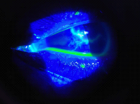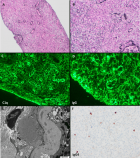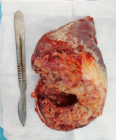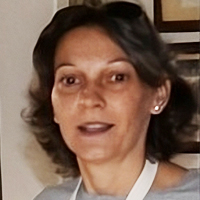Abstract
Case Report
Pathological left ventricular hypertrophy and outflow tract obstruction in an infant of a diabetic mother: A case report
Ujuanbi AS*, Onyeka CA, Yeibake WS, Oremodu T, Kunle-Olowu OE and Otaigbe BE
Published: 03 March, 2020 | Volume 5 - Issue 1 | Pages: 047-050
Background: Infants of diabetic mothers (IDMs) are at increased risk of developing congenital anomalies including cardiac defects. Pathological left ventricular hypertrophy, asymmetrical septal hypertrophy and outflow tract obstruction is a rare but known cardiac comorbidity in infants of diabetic mothers. The severity of this condition in IDMs can vary from an incidental finding on echocardiography to an infant with severe symptoms of congestive heart failure and specific management of the condition varies.
Aim: The aim of this article is to report this clinical entity in a Nigerian infant born to a mother with poor glycaemic control in pregnancy and highlight management.
Case report: We report a term neonate who was diagnosed as a case of pathological left ventricular hypertrophy, asymmetrical septal hypertrophy and outflow tract obstruction delivered to a mother with gestational diabetics with poor glycaemic control in pregnancy. Child was treated successfully with β-adrenergic blocker and showed resolution of hypertrophy in follow-up echocardiography.
Conclusion: Infants of diabetic mothers are very high risk infants. Pathological left ventricular hypertrophy in IDM have good prognosis. Early recognition and prompt intervention is advocated.
Read Full Article HTML DOI: 10.29328/journal.jccm.1001085 Cite this Article Read Full Article PDF
Keywords:
Pathological left ventricular hypertrophy; Outflow tract obstruction; Infant of diabetic mother
References
- Venkat Rk, Aakash P, Anish P. Infant of diabetic mother: what one needs to know? J Matern Fetal Neonatal Med. 2020; 33: 482-492. PubMed: https://www.ncbi.nlm.nih.gov/pubmed/29947269
- Sharma D, Pandita A, Shastri S, Sharma P. Asymmetrical septal hypertrophy and hypertrophic cardiomyopathy infant of diabetic mother: a reversible cardiomyopathy. Med J. 2016; 9: 257-260.
- Buchanan TA, Kitzmiller JL. Metabolic interactions of diabetes and pregnancy. Annu Rev Med. 1994; 45: 245-260. PubMed: https://www.ncbi.nlm.nih.gov/pubmed/8198381
- Russell NE, Holloway P, Quinn S, Foley M, Kelehan P, et al. Cardiomyopathy and cardiomegaly in stillborn infants of diabetic mothers. Pediatr Dev Pathol. 2008; 11: 10-14. PubMed: https://www.ncbi.nlm.nih.gov/pubmed/18237240
- Demiroren K, Cam L, Oran B, Koç H, Başpinar O, et al. Echocardiographic measure-ments in infants of diabetic mothers and macrosomic infants of nondiabetic mothers. J Perinat Med. 2005; 33: 232-235. PubMed: https://www.ncbi.nlm.nih.gov/pubmed/15914346
- Park MK. Pediatric cardiology. 4th ed. St. Louis: Mosby; 2002. Primary myocardial disease. 2002; 267-392.
- Ullmo S, Vial Y, Di Bernardo S, Roth-Kleiner M, Mivelaz Y, et al. Pathologic ventricular hypertrophy in the offspring of diabetic mothers: a retrospective study. Eur Heart J. 2007; 28: 1319–1325. PubMed: https://www.ncbi.nlm.nih.gov/pubmed/17158827
- Hay WW. Care of the infant of the diabetic mother. Curr Diab Rep. 2012; 12: 4–15. PubMed: https://www.ncbi.nlm.nih.gov/pubmed/22094826
- Reller MD, Kaplan S. Hypertrophic cardiomyopathy in infants of diabetic mothers: an update. Am J Perinatol. 1988; 5: 353-358. PubMed: https://www.ncbi.nlm.nih.gov/pubmed/2971360
- Way GL, Wolfe RR, Eshaghpour E, Bender RL, Jaffe RB, et al. The natural history of hypertrophic cardiomyopathy in infants of diabetic mothers. J Pediatr. 1979; 95: 1020-1025. PubMed: https://www.ncbi.nlm.nih.gov/pubmed/159352
- Goodwin JF. A current appraisal of the cardiomyopathies. Hosp Update. 1979; 5: 665-683
- Poland R L, Walther LJ, Chang L. Hypertrophic cardiomyopathy in infants of diabetic mothers (abstract). Pediatr Res. 1975; 9: 269.
- Way GL, Ruttenberg HD, Eshaghpour E, Nora JJ, Wolfe RE. Hypertrophic obstructive cardiomyopathy in infants of diabetic mothers (abstract). Circulation. 1976; 53-54.
- Gutgesell HP, Mullins CE, Gillette PC, Speer M, Rudolph AJ, et al. Transient hypertrophic subaortic stenosis in infants of diabetic mothers. J Pediatr. 1976; 89: 120-125. PubMed: https://www.ncbi.nlm.nih.gov/pubmed/945337
- Maron BJ, Edwards JE, Henry WL, Clark CE, Bingle GJ, et al. Asymmetric septal hypertrophy (ASH) in infancy. Circulation. 1974; 50: 809-820. PubMed: https://www.ncbi.nlm.nih.gov/pubmed/4278818
- Halliday HL. Hypertrophic cardiomyopathy in infants of poor1y-controlled diabetic mothers. Arch Dis Childhood. 1981; 56: 258-263.
- Howard PG, Michael ES, Harvey SR. Characterization of the Cardiomyopathy in Infants of Diabetic Mothers. Circulation. 1980; 61: 441-450. PubMed: https://www.ncbi.nlm.nih.gov/pubmed/6444280
- Bulkley BH, Weisfeldt ML, Hutchins GM. Isometric cardiac contraction. a possible cause of the disorganized myocardial pattern of idiopathic hypertrophic subaortic stenosis. N Engl J Med. 1977; 296: 135-139. PubMed: https://www.ncbi.nlm.nih.gov/pubmed/556638
- Denfield SW, Gajarski RJ, Towbin JA. Cardiomyopathies. In: Garson AG, Bricker JT, Fisher DJ, Neish SR, editors. The Science and Practice of Pediatric Cardiology. 1998; 1851.
Figures:
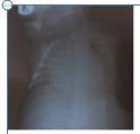
Figure 1
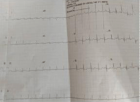
Figure 2
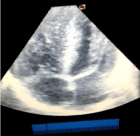
Figure 3
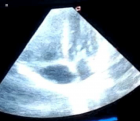
Figure 4
Similar Articles
-
Pathological left ventricular hypertrophy and outflow tract obstruction in an infant of a diabetic mother: A case reportUjuanbi AS*,Onyeka CA,Yeibake WS, Oremodu T,Kunle-Olowu OE,Otaigbe BE. Pathological left ventricular hypertrophy and outflow tract obstruction in an infant of a diabetic mother: A case report. . 2020 doi: 10.29328/journal.jccm.1001085; 5: 047-050
Recently Viewed
-
Investigation of Stain Patterns from Diverse Blood Samples on Various SurfacesSonia Rajkumari*. Investigation of Stain Patterns from Diverse Blood Samples on Various Surfaces. J Forensic Sci Res. 2024: doi: 10.29328/journal.jfsr.1001061; 8: 028034
-
Prevalence of Risk factors of Non Communicable Diseases amongst Medical Students, Kanpur, Uttar Pradesh, IndiaLakshmi Singh*, Anju Gahlot, Atul Kumar Singh. Prevalence of Risk factors of Non Communicable Diseases amongst Medical Students, Kanpur, Uttar Pradesh, India. J Community Med Health Solut. 2024: doi: 10.29328/journal.jcmhs.1001048; 5: 057-061
-
Psychosis in Parkinson’s Disease and Current Management Trends- an Updated Review of LiteratureRajib Dutta*. Psychosis in Parkinson’s Disease and Current Management Trends- an Updated Review of Literature. J Neurosci Neurol Disord. 2023: doi: 10.29328/journal.jnnd.1001078; 7: 027057
-
Enhancing adipose stem cell chondrogenesis: A study on the roles of dexamethasone, transforming growth factor β3 and ascorbate supplements and their combinationBernard J Van Wie*,Arshan Nazempour##,Chrystal R Quisenberry##,Nehal I Abu-Lail. Enhancing adipose stem cell chondrogenesis: A study on the roles of dexamethasone, transforming growth factor β3 and ascorbate supplements and their combination. J Stem Cell Ther Transplant. 2017: doi: 10.29328/journal.jsctt.1001004; 1: 028-051
-
Sinonasal Myxoma Extending into the Orbit in a 4-Year Old: A Case PresentationJulian A Purrinos*, Ramzi Younis. Sinonasal Myxoma Extending into the Orbit in a 4-Year Old: A Case Presentation. Arch Case Rep. 2024: doi: 10.29328/journal.acr.1001099; 8: 075-077
Most Viewed
-
Evaluation of Biostimulants Based on Recovered Protein Hydrolysates from Animal By-products as Plant Growth EnhancersH Pérez-Aguilar*, M Lacruz-Asaro, F Arán-Ais. Evaluation of Biostimulants Based on Recovered Protein Hydrolysates from Animal By-products as Plant Growth Enhancers. J Plant Sci Phytopathol. 2023 doi: 10.29328/journal.jpsp.1001104; 7: 042-047
-
Sinonasal Myxoma Extending into the Orbit in a 4-Year Old: A Case PresentationJulian A Purrinos*, Ramzi Younis. Sinonasal Myxoma Extending into the Orbit in a 4-Year Old: A Case Presentation. Arch Case Rep. 2024 doi: 10.29328/journal.acr.1001099; 8: 075-077
-
Feasibility study of magnetic sensing for detecting single-neuron action potentialsDenis Tonini,Kai Wu,Renata Saha,Jian-Ping Wang*. Feasibility study of magnetic sensing for detecting single-neuron action potentials. Ann Biomed Sci Eng. 2022 doi: 10.29328/journal.abse.1001018; 6: 019-029
-
Pediatric Dysgerminoma: Unveiling a Rare Ovarian TumorFaten Limaiem*, Khalil Saffar, Ahmed Halouani. Pediatric Dysgerminoma: Unveiling a Rare Ovarian Tumor. Arch Case Rep. 2024 doi: 10.29328/journal.acr.1001087; 8: 010-013
-
Physical activity can change the physiological and psychological circumstances during COVID-19 pandemic: A narrative reviewKhashayar Maroufi*. Physical activity can change the physiological and psychological circumstances during COVID-19 pandemic: A narrative review. J Sports Med Ther. 2021 doi: 10.29328/journal.jsmt.1001051; 6: 001-007

HSPI: We're glad you're here. Please click "create a new Query" if you are a new visitor to our website and need further information from us.
If you are already a member of our network and need to keep track of any developments regarding a question you have already submitted, click "take me to my Query."








